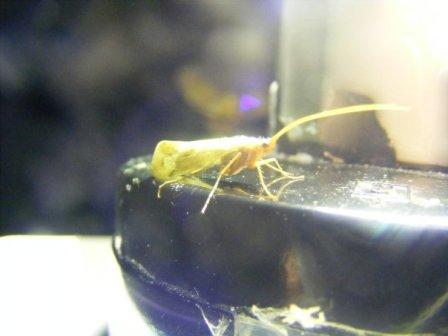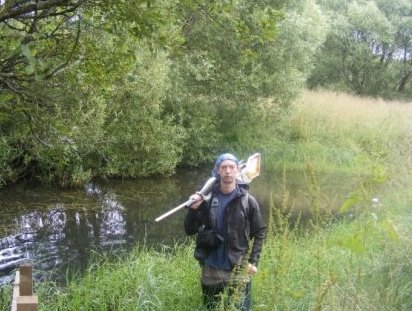Hi, Louis here, the riverfly apprentice. After over 5 months in the job I guess it’s about time to put up a few words about the many and varied activities that have filled my working days (i.e. life) for the opening third of my apprenticeship.
So, to start just before the beginning, I was struggling to make ends meet on a part time dishwashers wage in Bristol, while volunteering all my free time to the Avon Wildlife Trust … basically I was just your everyday zoology graduate. Job hunting was proving fruitless and I was beginning to doubt my chosen vocation, when along comes a series of adverts for Natural Talent Apprenticeships. Paid work actually giving ME the sort of experience everyone else is asking for, but nobody else seems able to provide. Seemed worth filling out an application form for, the only question was which of these wonderful positions to apply for. Well, I admit I was tempted to apply for a position roaming the glorious machair of the wild Western Isles, or perhaps a stay in stately Edinburgh to work with those most glamorous and socially acceptable insects, the Lepidoptera. But no, there was only one position for me. Which is why I’m currently sat in the middle of Glasgow, surrounded by dead flies.
 And I wouldn’t swap it for anything. Freshwater life has always interested me, and it didn’t take long for that interest to develop into a passion. I’ve never really had (or at least have never taken) the chance to study anything in as much detail, with as much freedom, as I’m currently able to do with riverflies. And I can tell you that they are fascinating. Did you know that there are swarms of mayflies in America that emerge in such numbers, and fly so briefly, that their corpses can cause drifts that block roads? Or that there is a species of parasitic wasp that preys solely on one small family of caddisflies, crawling under the water to lay a single egg into a pupal case, then leaving its larvae to devour the host and construct an external “gill” to keep it alive inside the stolen shell in which it will spend the majority of its lifecycle? Or that many adult stoneflies, though rubbish at flying, can skim across the water’s surface, sometimes rearing up on two legs like ice skaters?
And I wouldn’t swap it for anything. Freshwater life has always interested me, and it didn’t take long for that interest to develop into a passion. I’ve never really had (or at least have never taken) the chance to study anything in as much detail, with as much freedom, as I’m currently able to do with riverflies. And I can tell you that they are fascinating. Did you know that there are swarms of mayflies in America that emerge in such numbers, and fly so briefly, that their corpses can cause drifts that block roads? Or that there is a species of parasitic wasp that preys solely on one small family of caddisflies, crawling under the water to lay a single egg into a pupal case, then leaving its larvae to devour the host and construct an external “gill” to keep it alive inside the stolen shell in which it will spend the majority of its lifecycle? Or that many adult stoneflies, though rubbish at flying, can skim across the water’s surface, sometimes rearing up on two legs like ice skaters?
Well now you do, and so do I for that matter, thanks to Natural Talent. Of course it isn’t all playing with bugs to find interesting conversation pieces (the parasitic wasp is a great one over dinner, when you can go into all the gory details I spared you here). The bulk of what I’ve been doing has been to work with the Clyde River Foundation, sampling and identifying various river insects for use in assessing the health of rivers. I’ve learnt techniques for biological sampling in rivers, and am currently working through a set of kick samples (samples collected by basically kicking the river bed and letting the flow carry the disturbed invertebrates into a net – generally along with lots of plants and gravel which has to be separated out) taken down a stem of the Clyde, from the source down into Glasgow itself. Hopefully these should provide some very useful data for various aspects of the management of the Clyde catchment.
 An aspect of the job that I’m coming to appreciate more and more, is the educational side of things. At various community-engagement events attended by the BTCV and Clyde River Foundation, I’ve really enjoyed showing off the incredible diversity of life beneath the water’s surface. Many people have no idea, and I hope that one or two of the kids who have come to play with the beasties have gone away and asked their parents for a pond net. Freshwater biologists in the making. The Clyde River Foundation are holding an event for schools soon, called Meet your River, in which several classes of primary school kids will descend on a river in Glasgow to learn all about what lies beneath. It’s an ambitious project and I’m really quite excited to be taking part.
An aspect of the job that I’m coming to appreciate more and more, is the educational side of things. At various community-engagement events attended by the BTCV and Clyde River Foundation, I’ve really enjoyed showing off the incredible diversity of life beneath the water’s surface. Many people have no idea, and I hope that one or two of the kids who have come to play with the beasties have gone away and asked their parents for a pond net. Freshwater biologists in the making. The Clyde River Foundation are holding an event for schools soon, called Meet your River, in which several classes of primary school kids will descend on a river in Glasgow to learn all about what lies beneath. It’s an ambitious project and I’m really quite excited to be taking part.
Well this may be starting to get long-winded, so I’ll keep the rest brief, although I’ve barely scratched the surface of everything I’ve been doing. I’ve been on various courses and workshops, a caddisfly workshop in Stirling with Ian Wallace, a mayfly and stonefly workshop in Shropshire with Craig MacAdam, a general aquatic invertebrate course at Loch Lomond, and a course at Lake Windermere looking at monitoring the health of freshwaters by identifying the shed pupal skins of Chironomids (it was interesting, I promise). I’ve been out with SEPA to learn about the role they play in protecting our rivers. Been along to several meetings of like-minded people, such as the Riverfly Partnership, Scottish Freshwater Group and Edinburgh Entomological Society. Oh, and also I went to visit Amy for a couple of days of riverfly recording in Insh Marshes, looking at the caddisflies in her mothtraps as well as scouring the site for whatever else I could find. Most excitingly, this turned up a mayfly species, Procloeon bifidum, not found within 100km of the site before.
Finally, just a little note on how the apprenticeship has spilled over into my free time too. I recently joined the Friends of the River Kelvin (FORK), a group dedicated to looking after my local river, on a voluntary basis. And I’ve been elected to the committee as the group’s biologist. Already I’ve shown a few enthusiastic FORKs some of the bugs living in their river, and I’m hoping I can introduce a new dimension to the excellent work they already do in cleaning up the Kelvin.
That’s all for now. See you in another 5 months! (Just kidding John)
